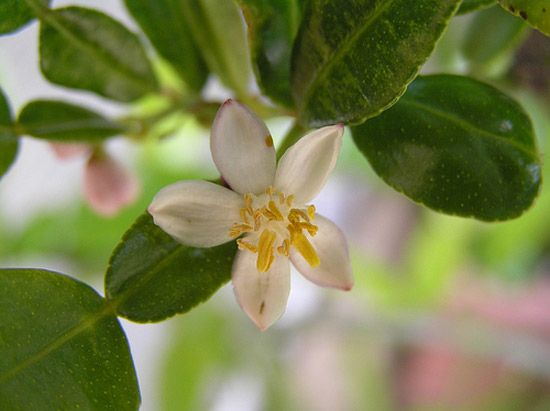Who Needs Fruit?—Kaffre Lime
Over the extent of my professional career, and this is not an exaggeration, several hundred people have proudly told me, "I planted some orange (or lemon or lime or grapefruit) seeds, and they are growing!" The follow-up inquiry is inevitable: "How long before they bear fruit?" I am doomed by my profession to explain that the beloved seedlings will not likely bear fruit. I truly hate dashing people's hopes of horticultural success, but my job is to enlighten.
Thankfully there exists for lovers of indoor gardening and ethnic cooking a citrus whose foliage—and not the fruit—is the prime objective: the kaffre lime, Citrus hystrix. Whew and amen!

Kaffre lime a small thorny tree 10 to 15 feet tall and 8 to 10 feet wide. Its species name hystrix refers to its bristliness or spininess. It bears dark green, alternate foliage with a distinctive shape—the winged petiole is roughly the same size as the leaf blade itself, creating an hourglass form. The highly aromatic leaves of kaffre lime (and the pithy, nearly juiceless fruit) are not at all sweet like a navel orange but spicy, and are integral to many Southeast Asian cuisines. A fertile tree produces auxiliary clusters of fragrant white blossoms that are followed upon pollination by wrinkled, warty, two-inch-long fruit that start out dark green and ripen to lemon yellow.
The tree, which is believed to have originated in Southeast Asia, is cultivated from Sri Lanka through Myanmar to Thailand (where it is called ma-kruut), Malaysia (where it is known as limau purut), and the Philippines. In Thailand, almost every home in the countryside has a kaffre lime tree in its yard. The juice of the fruit is used as a cleanser and stain remover, and the zest is a natural deodorizer with a sparkling scent like a sweet bouquet of citrus blossoms. Kaffre lime's aromatherapeutic and astringent qualities make it a popular ingredient in shampoo and cosmetics. It is also used to repel insects. For a fragrantly invigorating pampering, throw a few leaves into your next bubble bath.
In folk medicine, kaffre lime is considered very salubrious—it's even thought to ward off evil spirits. On a more corporeal level, the juice of kaffre lime is recommended for maintaining tooth and gum health. The essential oils in the fruit are used in topical ointments, and the rind is an ingredient in blood tonics. Kaffre lime is also considered beneficial to the digestive system.
The rind of kaffre lime may be candied or dried for use in curries and pastries, and the fruit is eaten with fish and made into beverages, but the leaves are this plant's crowning culinary feature. The fresh or dried leaves impart a pleasant citrus flavor when added to soups and curries. In Indonesia, fresh leaves are pounded into a jelly and mixed with hot chile paste. The leaves can be stored either whole or ground in the freezer (homegrown frozen leaves are infinitely tastier than commercially procured dried ones).
In the garden, this citrus can withstand a minimum temperature of 45°F (established trees can survive short periods as low as 32°F). Fortunately, it makes a great container plant, which can be brought inside for the winter months or grown indoors year-round in a very sunny (south, west, or southwest exposure) but cool window. Citrus plants hate the dry heat of our infernally set radiators and demand plenty of fresh, moving air indoors. A small clip-on fan and occasional misting can help counteract wintertime stuffiness. A summer vacation outdoors will work wonders for even the saddest specimen. Indoors, watch for spider mites, mealy bugs, and scale as pests. Outdoors, be aware of aphids on the new growing tips as well as the diseases citrus canker and citrus scab. Use your favorite IPM controls to keep pests at a minimum.
The best soil for citrus is compost rich, water retentive yet well draining, and about 5.5 to 6.0 in pH. Any nutritionally complete potting soil can be enhanced with the addition of coir or compost. Pine needles and chopped oak leaves are wonderful natural acidifiers, as are coffee grounds and used tea leaves (ask your favorite café for its refuse). You may also opt to employ an acidifying fertilizer (granular or water soluble) made specifically for citrus, as these plants have particular requirements for micronutrients that most fertilizers do not contain.
Shrimp Topping for Khao Neeo Moon
- 1 cup shelled, finely chopped shrimp (or extra firm tofu)
- 1 cup fresh, grated coconut
- 2 tablespoons finely chopped fresh kaffre lime leaves
- Pinch ground turmeric, for coloring
- 2 tablespoons cooking oil
- 2 tablespoons finely chopped coriander root
- 1 teaspoon coarsely ground black pepper
- salt and sugar to taste
- 2 tablespoons chopped fresh coriander leaves
Mix shrimp (or tofu), coconut, and kaffre lime leaves together with the turmeric and set aside. Heat the oil in a skillet or wok, add the chopped coriander root and pepper, and stir-fry until fragrant. Add the shrimp mix and cook 3 to 4 minutes, or until the shrimp is done. Season to taste with salt and sugar. Sprinkle with chopped coriander leaves and serve with sticky rice steeped in coconut milk. Makes 3 to 6 servings.


